The Parthenon is a famous temple on the Acropolis in Athens, Greece, built between 447 and 432 BCE. Designed in the Doric architectural style by Iktinos and Kallikrates, it featured a sculptural program by Phidias. Originally housing a giant statue of Athena, the Parthenon is acclaimed for its Doric columns and optical refinements. Over time, it suffered significant damage, notably in 1687 and by Lord Elgin in the 19th century. The temple’s design and construction employed advanced structural engineering principles, like the post and lintel system, entasis in columns, and a coffered ceiling, balancing aesthetic perfection with functional requirements. The design reflected Greek cultural traditions, with Doric columns, triglyphs, and metopes, and it celebrated Athenian identity and power post-Persian Wars. Ongoing restoration of the Parthenon involves replacing damaged sections with new marble and using titanium for metal elements. The project aims to preserve the temple while respecting its historical integrity. Despite not complying with modern standards, efforts have been made to enhance visitor accessibility. The site offers specialized tours for architects, highlighting its architectural significance and innovations. The Parthenon’s lessons in architectural form, proportions, and integration of arts remain valuable for modern architects.
What is the Parthenon?
The Parthenon is a temple located on the Acropolis in Athens, Greece. It was built between 447 and 432 BCE during the height of Ancient Greece’s cultural and political power under the direction of the Athenian statesman Pericles. The architects were Ictinus and Callicrates, and the sculptural program was overseen by the known sculptor Phidias. It was built to replace an earlier temple the Persians destroyed and house a giant gold and ivory statue of Athena, the patron goddess of Athens. The Parthenon is considered the finest example of Doric architecture. It is built entirely of Pentelic marble and incorporates architectural refinements to counter optical illusions and make it appear straight.
The temple was decorated with sculptures depicting Greek myths, and the Panathenaic procession was held every four years in honor of Athena. This included 92 metopes showing the Gigantomachy, Amazonomachy, Centauromachy, and Trojan War—a 529-foot (160-meter) depicting the Panathenaic procession. Pediment sculptures show Athena’s birth and the contest between Athena and Poseidon. The most famous sculpture was the 40-foot (12-meter) tall gold and ivory statue of Athena Parthenos by Phidias, which once stood inside. The Parthenon remained largely intact until 1687, when a Venetian army bombarded the Acropolis and caused a Turkish gunpowder store inside to explode, destroying much of the interior. Further damage occurred in the 19th century when Lord Elgin removed many sculptures to take to England.
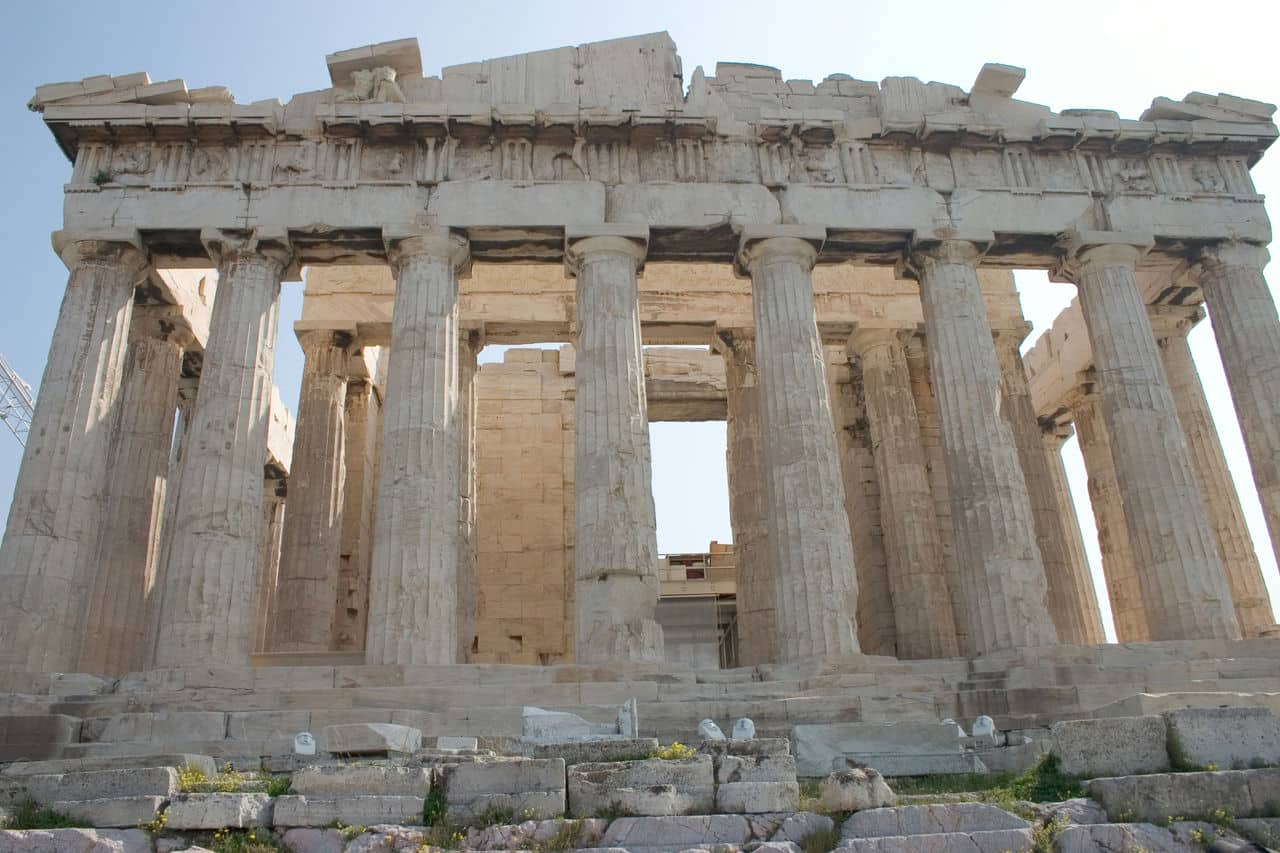
What architectural style is most prominent in the Parthenon?
The Parthenon is designed in the Doric architectural style, the most prominent style across the temple. The Parthenon epitomizes Doric architecture in its exterior colonnade and the structural form of the inner cella. The temple features a perimeter of Doric columns, with eight columns across the short ends and 17 along the more extended flanks. This column arrangement created a larger, more monumental exterior colonnade than was typical of Greek temples. The columns have a simple Doric capital and no base, giving them a sturdy appearance suited to supporting the entablature.
The Parthenon strictly adheres to Doric conventions in the entablature and other detailing. The stylobate platform and pediments also align with the Doric style. The one major exception is the continuous Ionic frieze incorporated along the top of the cell walls. However, the dominance of the Doric order is upheld through the columns, capital, and roof details. The Parthenon’s Doric style projected a bold, structured aesthetic befitting a temple to Athena in a city that prized learning, wisdom, and martial strength. The style’s simplicity kept ornamentation from distracting worshipers, allowing them to focus on the monumental statue.
What structural engineering principles were employed in the construction of the Parthenon?
The Parthenon employed ancient Greek structural engineering principles and innovations. The Parthenon features a post and lintel system with closely spaced columns carrying the load of the entablature and pedimented roof. This allowed the creation of an ample interior space uninterrupted by supports. The stylobate platform also distributed the building’s weight evenly into the ground. Engineers employed a double-wall technique, filling between blocks with rubble cement for stability. The Parthenon’s columns display entasis, or a slight swelling, improving their load-bearing appearance. This clever use of forced perspective demonstrated Greek structural know-how. Innovations like the coffered ceiling reduced the roof’s mass. Ionic columns on a raised platform within the cella created a grandeur appropriate for the Athena Parthenos statue. The Parthenon’s form elegantly balanced aesthetic perfection with functional load-bearing requirements through structural refinements. Its engineering advanced temple construction by realizing an airy interior fitted to its religious purpose. The building’s longevity and resilience through 24 centuries owes significantly to the mastery of its structural design.
Who designed the Parthenon?
The Parthenon was designed by the architects Iktinos and Kallikrates under the direction of the sculptor Phidias. The Parthenon owes its existence to a massive rebuilding program on the Athenian Acropolis conceptualized by statesman Perikles following the Persian sacking of the site in 480 BCE. To create unparalleled sanctuaries for the patron goddess Athena, Perikles commissioned the architects Iktinos and Kallikrates to design an imposing new Doric temple to replace the ruined Older Parthenon around 447 BCE. Iktinos and Kallikrates conceived the Parthenon’s physical form and layout. The sculptor Phidias was closely involved throughout construction, which concluded in 432 BCE. Phidias recommended the pair of relatively unknown architects based on past collaborations. Iktinos and Kallikrates made ingenious innovations to the typical Doric design to realize Perikles’ ambitions. This included incorporating Ionic elements like the continuous frieze. The architects also employed subtle optical refinements to correct visual distortions in a mammoth building. Phidias was the most acclaimed sculptor in 5th-century Greece. His fame brought prestige to the Parthenon project. He oversaw the carving of the pediment, metope, and frieze reliefs. Phidias also created the massive Athena Parthenos statue, the temple’s crowning glory. His diverse works unified to glorify the goddess, city, and Athenian empire.
What are the historical design influences visible in the Parthenon?
The Parthenon displays design influences from ancient Greek architecture and culture. The Parthenon influences the Doric architectural style strongly tied to Greek cultural identity. The temple’s perimeter of Doric columns, use of triglyphs and metopes, and other adherence to forms developed centuries prior link it to the heritage of major Greek sanctuaries. Architects Iktinos and Kallikrates incorporated optical refinements like entasis and stylobate curvature, demonstrating knowledge gleaned from generations of temple builders before them. Its relief sculpture style had decorated temples for centuries. The subjects depicted also carried on the practice of glorifying local religious beliefs and civic triumphs. On a deeper level, the Parthenon’s construction invoked the splendor of Minoan and Mycenaean Bronze Age palaces. The columned central hall and overall monumentality directly recalled these mythic forerunners. The choice of fine Pentelic marble linked the Parthenon to the nearby towering temples of the Archaic Acropolis.
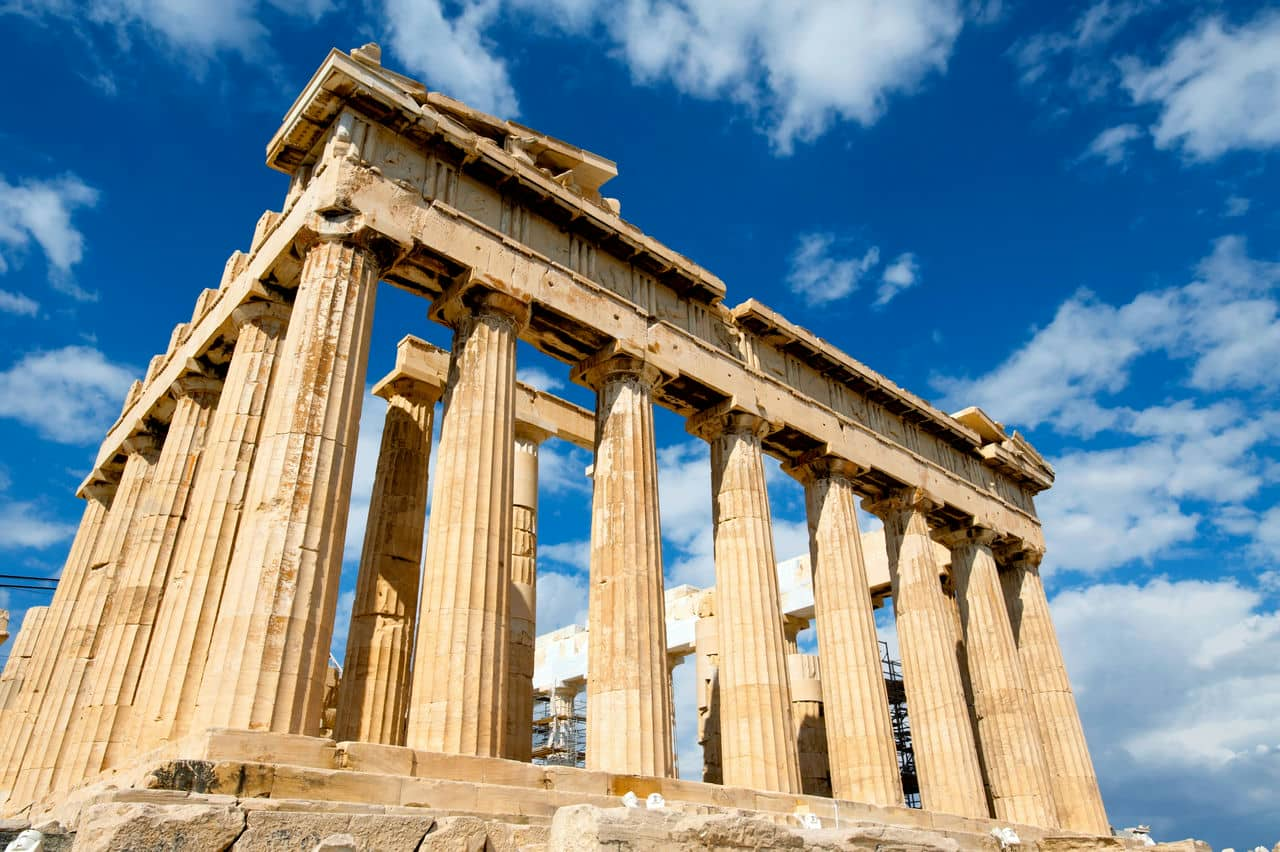
How has the Parthenon influenced the design of other buildings in Greece?
The Parthenon has significantly influenced the design of buildings across Greece over the centuries. As the pinnacle of ancient Greek architecture, the Parthenon has served as an inspiration for many later buildings in Greece. Its pioneering use of sophisticated optical refinements and harmonious proportions created ideals of beauty and visual perfection that architects have sought to emulate. In the 19th century, there was great interest in reviving Greek architectural styles as a symbol of cultural continuity with the glories of classical antiquity. Buildings such as the Old Royal Palace in Athens adapted Parthenon-esque features like a central entrance flanked by columns. During this Neoclassical period, public buildings across Greece drew heavily on Athenian models like the Parthenon. In the 20th century, modernist architects continued experimenting with form, functionality, and meaning inspired by the classical style the Parthenon epitomizes. Even contemporary buildings like the Athens Concert Hall reference the Parthenon’s geometry and openness through glass walls and clean lines. The grandeur, refinement, and visual harmony of the Parthenon continue to motivate architects seeking to capture the power and beauty of this icon of Greek identity. From overt replicas to more abstract interpretations, the temple’s proportions, columns, and sculptural details have shaped the landscape of Greece for over two millennia.
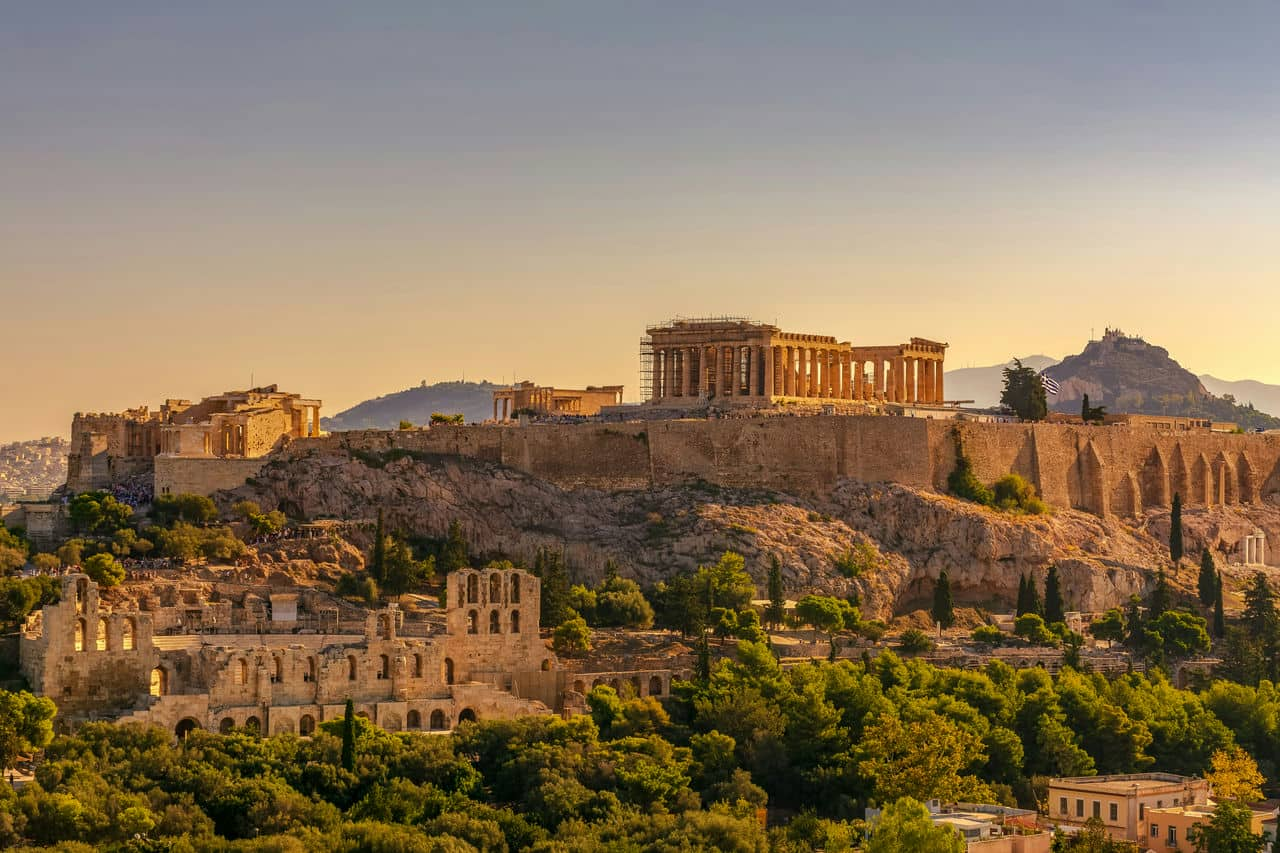
What purpose does the Parthenon serve, and how does the design help?
The Parthenon was built as a temple to honor the goddess Athena and to house her massive gold and ivory cult statue. The imposing architecture, with tall columns surrounding all sides, created an exterior that projected the power and importance of Athena as the patron goddess of Athens. The columns, pediments, and refined details also made the Parthenon a visual monument to Athena that could be seen around the city. The sculptures on the outside told stories honoring Athena and the achievements of Athens under her blessing. This reinforced devotion to the goddess within the populace. The grandeur, openness, and ornamentation of the Parthenon’s design focused attention on the worship of Athena. The temple used architecture and art to glorify the goddess at the heart of Athenian identity.
How is the Parthenon maintained?
The Parthenon has undergone extensive restoration and conservation efforts to preserve and protect the 2,500-year-old temple. Regular maintenance of the Parthenon involves ongoing inspection, cleaning, and minor repairs by archaeologists and restoration experts. More complex restoration projects have aimed to undo past damage and deterioration while respecting historical integrity. In the 19th and 20th centuries, early misguided efforts often caused more harm, using cement and iron that trapped water and accelerated decay. Since the 1970s, Greek experts have systematically studied, documented, and stabilized the structure. Damaged sections get new marble blocks from the original Pentelic quarry. Corrosion-resistant titanium is now used for crucial metal elements. A current focus is protecting the Parthenon’s delicate marble carvings. State-of-the-art laser scanning and photography allow virtual modeling to study the Parthenon and recreate lost pieces. Digital reconstructions also help visualize the original structure and guide ongoing conservation. Regular hands-on maintenance will always be needed to preserve the Parthenon for future generations.
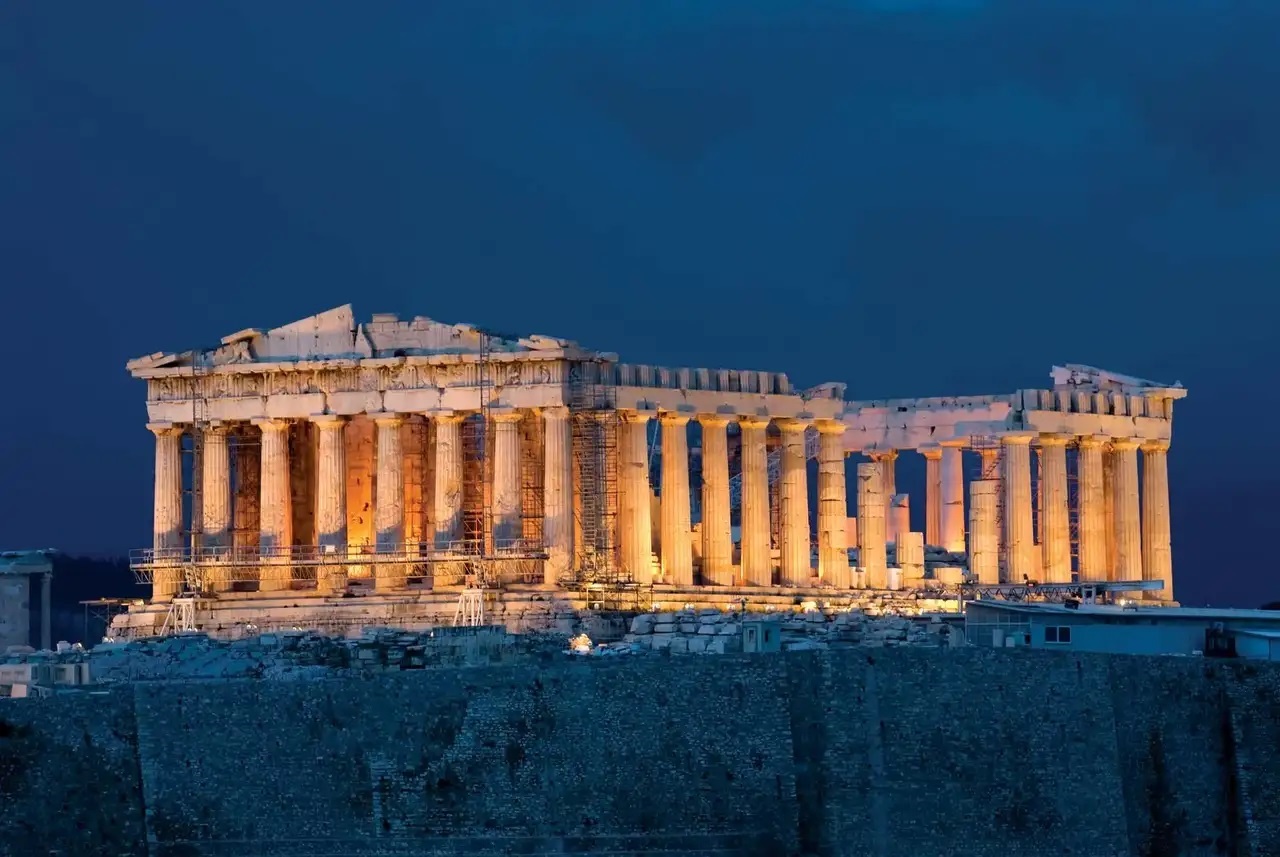
How does the Parthenon reflect cultural and contextual relevance in its design?
The Parthenon’s design drew heavily from Greek cultural traditions and the historical context in which it was built. The Parthenon was constructed in the 5th century BCE as part of a massive rebuilding program on the Acropolis of Athens following its destruction by the Persians. Its rows of Doric columns, triangular pediments, and adherence to established proportions connected it to the heritage of major Greek sanctuaries. Carved metopes illustrated legendary confrontations between Greeks and neighboring powers, promoting ideas of Athenian cultural superiority. Decorative details heralded the city’s prosperity under the democracy of Pericles. Sculptures like the Panathenaic frieze depicted the rituals of Athenian civic religion. Their prominent placement reflected pride in local traditions. The imposing architecture and sheer wealth of artistic embellishment were statements of Athenian identity and power following victory in the Persian Wars. Its design announced the city’s leadership in the Greek world through artistic excellence and invocation of a proud history. Even today, the Parthenon reflects Athenian and Greek identity.
What architectural trend or movement does the Parthenon represent?
The Parthenon represents the architecture of ancient Greece during the Classical period. This includes the temple’s sturdy Doric columns, triangular pediments, adherence to mathematical proportions for visual harmony, and other conventions linking it to revered Greek buildings from earlier eras. The Parthenon also embodied innovative engineering and artistic approaches that marked the peak of Classical achievement. The sculptural program overseen by Phidias brought together myth, religion, and contemporary life in a way not seen before. The metopes, pediments, and unprecedented marble frieze all glorified the goddess Athena and the virtues of Athens at the height of its influence and prosperity. Parthenon symbolized the confidence and burgeoning identity of 5th-century Athens. Even as Greece declined in subsequent eras, the Parthenon endured as an icon of the Classical ideals, artistry, and innovation that formed the foundation of Western culture for millennia.
What are the challenges faced during the restoration of the Parthenon?
The Parthenon has faced numerous challenges in its restoration over the past few decades. As one of the most recognized ruins of classical antiquity, the Parthenon poses unique difficulties for conservation efforts. Firstly, the temple endured centuries of alterations under various religious uses, wartime bombardment in 1687 that devastated the interior, pollution damage, and early misguided restoration attempts. A major challenge is retaining visual harmony while replacing or stabilizing damaged temple sections. Over half the original structure is missing, making it impossible to recreate the Parthenon’s original form fully. Secondly, restoring color to the Parthenon also faces obstacles. Traces show it was once brightly painted, but the exact pigments still need to be discovered. Integrating modern repairs into the existing ruin structurally and visually requires great skill. Lastly, as an outdoor ruin exposed to weathering, protection systems must be discreet yet effective at shielding the temple. The Parthenon endures regular seismic activity and sustained acid rain damage, too. Restricting visitor access aids preservation but reduces cultural access. The Parthenon’s complexity as an ancient ruin with architectural and sculptural elements to conserve makes restoration a monumental challenge.
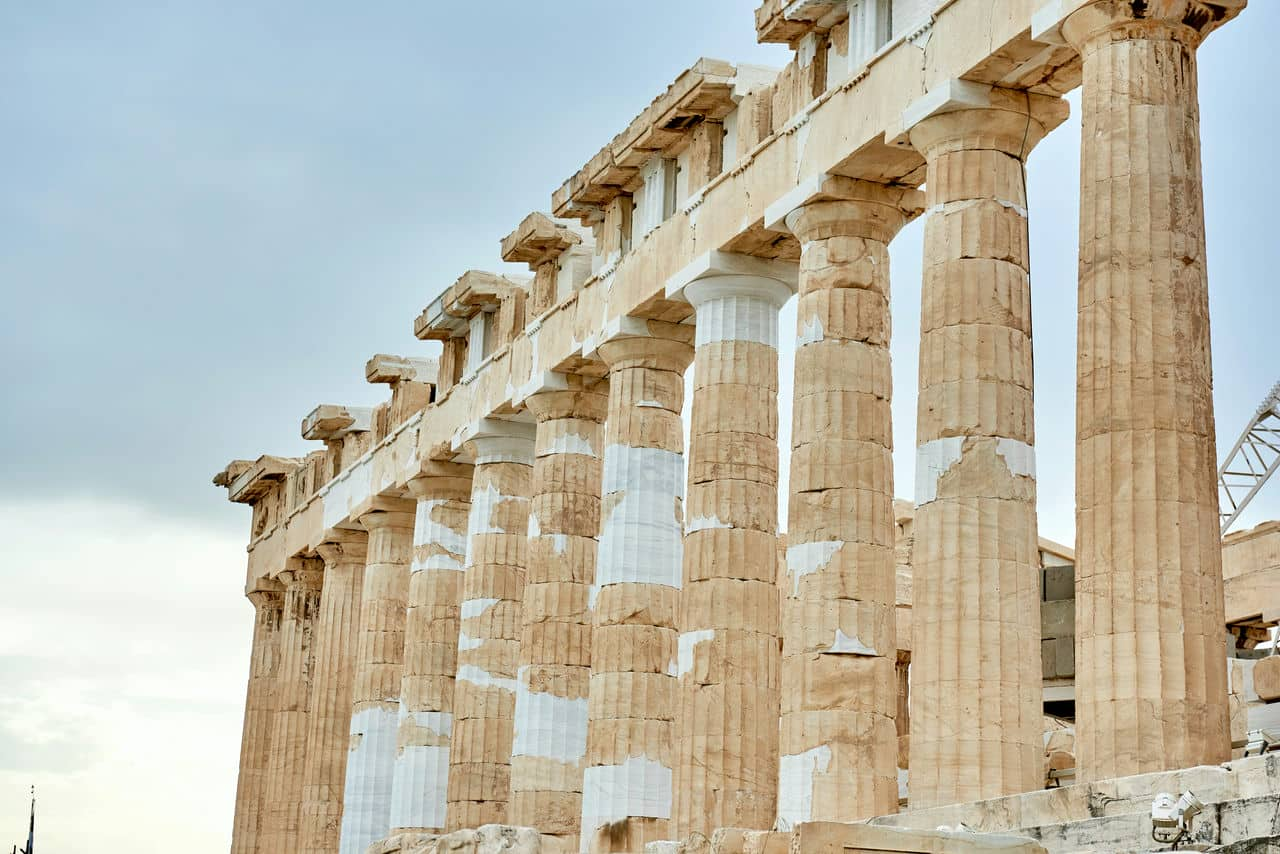
How does Parthenon comply with contemporary safety and accessibility standards?
As an ancient ruin, the Parthenon does not have to comply with modern building codes and accessibility laws. However, efforts have been made to protect visitors and provide access within the constraints of preserving this 2,500-year-old structure. The Parthenon poses inherent challenges regarding accessibility and safety due to its ruined state, elevated location, and historic preservation priorities. Parts of the form remain precarious. However, recent restorations have enhanced accessibility in feasible ways. New walkways include gradual ramps leading to temple entrances, allowing wheelchair access. The careful restoration practices balance preservation, sustainability, and access. The Parthenon cannot fully comply with modern standards, but reasonable efforts are made to provide meaningful improvements for visitors of all abilities within the context of an ancient site.
Are there any specific tours for architects or architecture enthusiasts visiting Parthenon?
Yes, several tours are available for architects and architecture enthusiasts visiting the Parthenon in Athens. The Acropolis with the Parthenon is one of the world’s most architecturally significant ancient sites. Various specialized tours allow visitors to explore the Parthenon and surrounding ruins from an architectural perspective. The Acropolis offers an architecture-focused guided tour providing an in-depth examination of the structural design and engineering innovations showcased across its ancient monuments. Guides discuss the optical refinements, harmonious proportions, and load-bearing capabilities behind the Parthenon’s construction. The tour also analyzes how the site’s ancient architects integrated the buildings and their religious functions into the natural landscape. Participants see contemporary engineering solutions and restoration techniques supporting the long-term sustainability of these ancient architectural marvels.
What lessons can architects learn from the design and construction of the Parthenon?
Architects can learn several key lessons from the Parthenon’s design and construction. Firstly, the Parthenon demonstrates how architectural form can embody cultural values. Its imposing yet refined Doric style extolled ideals like rationality and order associated with democratic Athens. Secondly, the Parthenon exemplifies proportions for perfection. Its architects employed mathematical ratios and optical illusions, so the temple appears symmetrical despite its size. Thirdly, the Parthenon also displays exemplary structural engineering to support open interior spaces. The coffered ceiling reduced load while increasing height for grandeur. Lastly, functional design innovations demonstrate problem-solving to balance gravity and openness. The temple’s extensive integrated ornamentation illustrates architecture enriched by other arts. This shows design elevated by artistic collaborations.
What are the best architectural landmarks in Greece to visit as an architect?
Listed below are the best architectural landmarks in Greece to visit as an architect.:
- The Parthenon, Athens: The Parthenon is a must-visit for architects exploring classical architecture and its enduring principles. Completed in 432 BC on the Acropolis, it was designed by Ictinus and Callicrates under the direction of the sculptor Phidias. This temple, dedicated to the goddess Athena, exemplifies the Doric order. It is famous for its proportional harmony and use of entasis (slight curvature of columns) to counteract optical illusions and sculptural details. The Parthenon’s beauty and structural ingenuity make it a pivotal study in the evolution of Western architecture.
- Theatre of Epidaurus: The Theatre of Epidaurus, dating back to the 4th century BC, is a significant site for architects studying ancient Greek theater design and acoustics. Designed by Polykleitos the Younger, this theater is famed for its exceptional acoustics, allowing even whispered words to be heard clearly throughout its 14,000 seats. Its integration with the natural landscape and the mathematical precision of its layout provide insights into Greek advancements in architectural design and urban planning.
- Temple of Hephaestus, Athens: The Temple of Hephaestus, one of the best-preserved ancient Greek temples, is crucial for architects examining classical temple architecture. Completed in 415 BC, it epitomizes the Doric order and provides a clear example of the mature classical style’s refinements in proportion and detail. The temple’s location in the ancient Agora of Athens makes it an essential study of the relationship between religious and civic architecture in ancient Greek cities.
- Palace of Knossos, Crete: The Palace of Knossos, the largest Bronze Age archaeological site on Crete, is a key destination for architects interested in Minoan architecture and urban planning. The palace, dating back to the second millennium BC, is notable for its complex layout, elaborate frescoes, and early examples of columns. Its design demonstrates advanced architectural techniques, including light wells, and is indicative of the sophisticated urban planning of the Minoan civilization.
- Meteora Monasteries: The Meteora Monasteries atop towering rock formations in central Greece offer architects a unique study of Byzantine architecture and the adaptation of buildings to challenging environments. These monasteries, dating from the 14th century, showcase a blend of natural and constructed elements, reflecting the ideal of withdrawal from the world.
- Delphi Archaeological Site: The archaeological site of Delphi, once considered the center of the world in ancient Greek religion, is significant for architects exploring the relationship between architecture, landscape, and mythology. The site includes the Temple of Apollo, the theater, and the stadium, set against the backdrop of Mount Parnassus. These structures offer a window into ancient Greek religious, cultural, and athletic practices, and their spatial arrangement and design reflect the importance of sacred geography in ancient architectural planning.
- Stoa of Attalos, Athens: The Stoa of Attalos, reconstructed in the 1950s, is pivotal for architects studying ancient Greek stoa architecture, which combined commercial, social, and civic functions. The original stoa, built around 150 BC, was a two-story building with a colonnade, providing a model for developing the public and commercial building typology in ancient Greece. The reconstruction, using ancient techniques and materials, also offers insights into historical preservation and restoration practices.
- Mystras: The archaeological site of Mystras, near Sparta, offers architects a comprehensive view of Byzantine architecture and urban design. Established in the 13th century, Mystras became a center of Byzantine culture and power. The site includes palaces, churches, monasteries, and houses on a hillside with a natural fortress-like quality.


